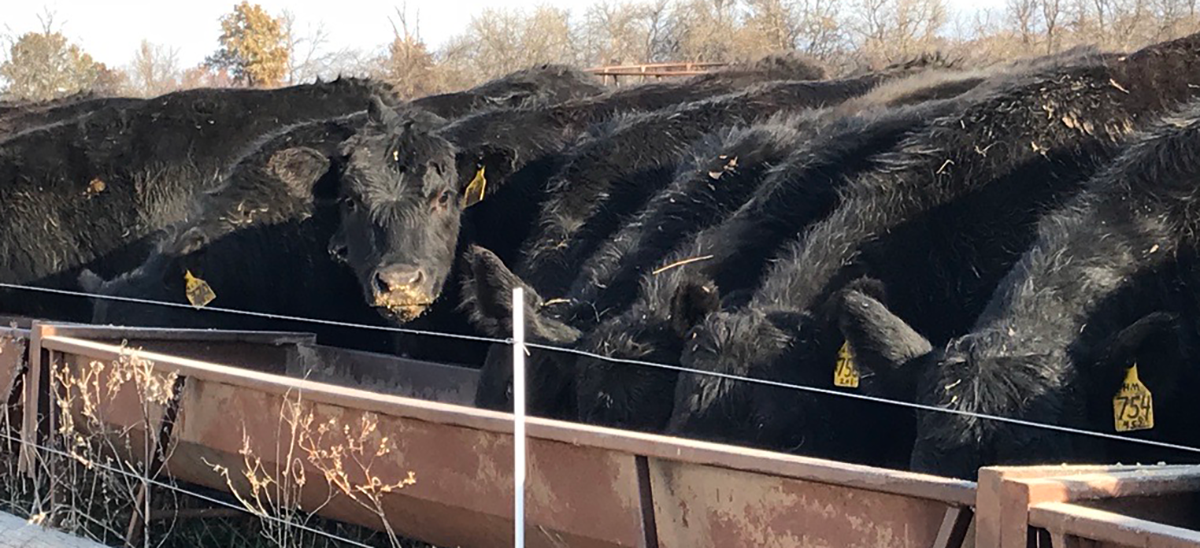
Should You Consider Limit-feeding Your Cow Herd?
Limit-feeding is an option when forages fail to meet the herd’s daily nutritional needs or when grazing could cause long-term damage to the forage base.
by Taylor Edwards, intern
Limit-feeding is not a typical strategy for most cow-calf operations, but it offers many benefits to consider, especially during times of drought and high feed prices. During a June 7 webinar, Jason Warner, extension cow-calf specialist at Kansas State University, shared advice for producers supporting limit-feeding on cow-calf operations. “Strategies for Feeding Cows with Limited Forages” is available online at https://www.youtube.com/watch?v=NyizkkjtuiA.
Limit-feeding is giving animals a limited amount of a high-energy ration to achieve a targeted maintenance level to preserve body weight and body condition score, says Warner. The time to consume the ration is much less, and cattle are restricted to three-quarters of ad libitum intake or less.
The cost per unit of energy is critical, says Warner, who advises pricing ingredients on a cost-per-unit-of-energy basis, then identifying how those feed ingredients can most effectively work in your situation.
Weighing benefits, management considerations
Limit-feeding comes with several benefits and considerations, especially for cow-calf producers, says Warner. Some advantages that may be overlooked are reduced manure output, minimized feed wastage and potential decreases in fly loads.
This is an effective strategy for reducing harvested forage needs and should be considered in two main circumstances, Warner says. Limit-feeding should be considered an option when you are providing half or more of an animal’s nutritional needs per day, or if you need to remove cattle from pasture or avoid turnout to prevent degradation or long-term damage to the forage base.
Be aware of the facilities, potential increases in management, and the potential to reduce feed costs and forage needs compared to feeding hay only, he says.
Giving consideration to bunk space is important. Warner suggests 24-36 inches (in.) per head to ensure adequate room for all to eat. Having the proper equipment to mix and deliver diets reliably, which increases costs and necessary management, is also something to keep in mind.
In addition to mixing rations, Warner says, expect increased management tasks such as calculating costs, sorting cows and feeding daily.
Determining what to feed
There are a few different ways to approach determining what to feed, but it ultimately comes down to understanding what the energy requirements are for that set of females with where they are in their production curve, says Warner.
“What I suggest or advise is identifying where those females are and understand where they’re going to be at on average or throughout the feeding period,” says Warner. “Then we’re going to calculate that amount we’re going to feed based on providing the amount of energy in order to meet their needs.”
These values can be determined from feed composition tables, nutrient requirement tables or a formulation software program. Warner recommends using the Beef Ration and Nutrition Decisions Software (BRaNDS) to assist in the formulation of rations. When figuring these values, remember the desired energy intake per day, energy concentration of the ration and ration dry matter.
Keep in mind, cows will be discontent for the first week or two, says Warner. Being consistent with the amount of feed, time of feeding, feed placement and distribution will help them adjust to a new feeding arrangement.
To learn more, access the “Strategies for Feeding Cows with Limited Forages” webinar online at https://www.youtube.com/watch?v=NyizkkjtuiA. Kansas State University offers resources to help plan hay needs and determine a budget for your cow-calf operation, which can help producers gauge the economic ramifications of limit-feeding.



